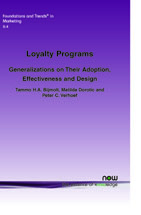Loyalty Programs: Generalizations on Their Adoption, Effectiveness and Design
By Tammo H. A. Bijmolt, Department of Marketing, Faculty of Economics and Business, University of Groningen, The Netherlands, t.h.a.bijmolt@rug.nl | Matilda Dorotic, Department of Marketing, Faculty of Economics, University of Split, Croatia, matilda.dorotic@efst.hr | Peter C. Verhoef, Department of Marketing, Faculty of Economics and Business, University of Groningen, The Netherlands, p.c.verhoef@rug.nl
Abstract
Loyalty programs (LPs) have increased in popularity, and have been studied extensively in the academic literature with mixed findings. Therefore, we offer an overview of extant research on LPs. We derive generalizations on the effectiveness and best design of LPs, discuss conditions that mediate and moderate the effects of LPs on customer behavior and attitudes, and highlight avenues for further research. Overall, we conclude that LPs are effective in increasing consumer purchase behaviors over time, but their impact differs across consumer segments and markets. Numerous practical examples illustrate the points discussed. Overall, this monograph provides insights to researchers and practitioners through a comprehensive, research-based synthesis of current knowledge. As a consequence, LP managers may better understand the implications of LP adoption, and ultimately improve the effectiveness of their LPs.
Loyalty Programs
Loyalty Programs: Generalizations on Their Adoption, Effectiveness and Design provides an overview of extant research on loyalty programs, derive generalizations on the effectiveness and best design of loyalty programs, and highlight avenues for further research. This monograph supports both researchers and practitioners through a comprehensive, research-based synthesis of current knowledge. In addition, it aims to help companies with loyalty programs improve their performance. Finally, companies that are still contemplating loyalty programs will better understand the implications of such programs through this overview.
